The Hyperbola Makes a Comeback
Lesson 4, Day 1
Information and Investigation Section
Information Section:
This information section objectives are:
1. State and apply properties of hyperbolas
to draw be able to draw or describe them.
2. Allow the student to use properties
of hyperbolas to write equations describing them.
Dandelin Spheres and the Hyperbola
Dandelin presents a way
of looking at the three-dimensional definition of a hyperbola
as a conic section and relating it to a two-dimensional definition
in terms of foci and focal constant. This is not very much different
than the approaches he took for the ellipse/circle. (Lesson
3)
Consider a hyperbola formed by a plane M intersecting
both nappes of a cone.
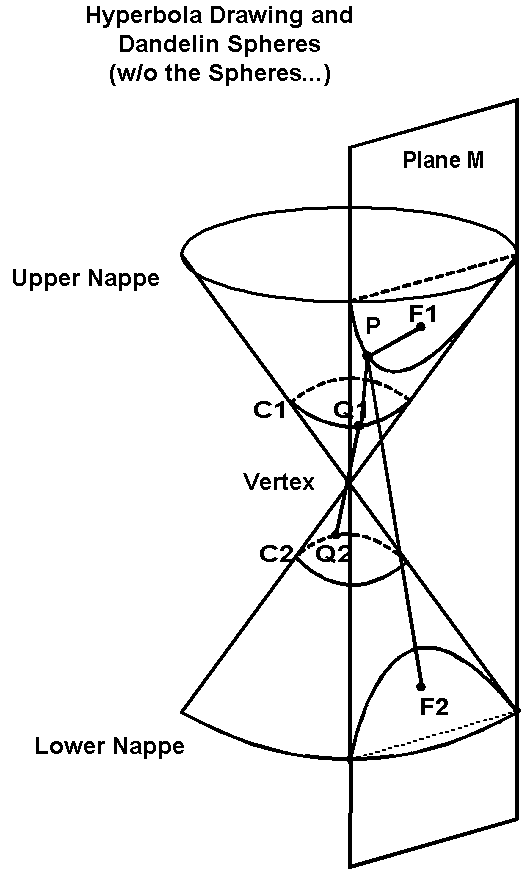
As was shown with the ellipse, two spheres
(S1 and S2) are tangent to the cone and to the plane M. (one
in each nappe). Let F1 and F2 be the points of tangency of the
speres with the plane and C1 and C2 be the circles of intersection
of the spheres and the cone.
There is a property that relates any point
P on the hyperbola to the fixed points F1 and F2. Suppose P is
on the nappe of the cone containing sphere S1. P is on the line
PV of the cone. Line PV will also intersect the circles C1 and
C2 at points Q1 and Q2, respectively. Note that Q1Q2 is the distance
along the edge between the circles C1 and C2. Also note that
the circles lie on parallel planes. This means that the distance
between Q1 and Q2 (Q1Q2) is constant independent of the position
of P.
Now notice that line segment PF1 and PQ1 are
tangents to sphere S1 from point P. Also, line segments PF2 and
PQ2 are tangents to sphere S2 from point P. Therefore:
PF1 = PQ1
and
PF2 = PQ2.
It follows that:
PF2-PF1 = PQ2-PQ1 = Q1Q2 (which is constant)
That means that PF2 - PF1 is also constant.
If P were located on the nappe of the other
cone, then the argument would result in:
PF1 - PF2 = PQ1 - PQ2 = Q1Q2...
the same constant as above.
Since either PF1-PF2 or PF2-PF1
= Q1Q2, then
| PF2 - PF1 | = Q1Q2
This property is normally taken as the two-dimensional
definition of a hyperbola.
A Two-Dimensional Definition of the Hyperbola
Theorem and Proof
Definition:
Let F1 anf F2 be two given points in a plane
and k be a positive real number with k < F1F2. Then the hyperbola with foci F1 and F2 and
focal constant k is the set of all
points in the planes which satisfy | PF1 - PF2 | = k.
In the example below, the hyperbola shown
has foci (F1 and F2) that are 2 units apart and k = 2.54. Notice
that unlike the ellipse, the hyperbola is unbounded. A point
can be farther than any specificed distance from either focus,
and still be 2.54 units closer to one focus than the other.

Hyperbolas have the same symmetries as ellipses.
Theorem:
A hyperbola with foci F1 and F2 is a reflection-symmetric
to line F1F2 and to the perpendicular bisector of the line segment
F1F2.
(Picture)
Proof: This
follows the same logic shown in the corresponding proof for the
ellipse, found in (Lesson
3). One need only replace the references of PF1 + PF2
= k with |PF1 - PF2 | = k to complete the proof.
Developing an Equation for a Hyperbola
Explanation:
From the two-dimensional definition of the
hyperbola, an equation for any hyperbola in the plane can be
found. A similar method as was used with the ellipse can be used.
If the foci are F1 = (a,b) and F2
= (c, d) and the focal constant is k, then any point
P = (x, y) on the hyperbola must satisfy the equation:

This is an equation for the hyperbola. It
appears to be unweildly and does not lend itself to graphing.
(even using Graphing Calculator, or other graphing tools). If
we choose our foci well, we may be able to find a less cumbersome
equation for the hyperbola. We can apply transformations to generate
equations for other hyperbolas.
Theorem (Equation for a Hyperbola)
By choosing foci at (c, 0) and (-c, 0) and
a focal constant of 2a we can yield the following equation for
the hyperbola:

Proof:
The proof is identical to proof for an
ellipse, in standard form, with two exceptions.
In Step 1, the definition of the hyperbola
is:

Also in step 1, if P = (x, y), F1 = (c,
0) and F2 = (-c, 0), then using the distance formula...

Steps 2 through 9 are then identical as
those shown for the ellipse.
In Step 10, there is another difference:

This accounts for the minus sign in the
equation for the hyperbola, where there is a plus sign for the
ellipse.
The complete proof is also provide here
below...
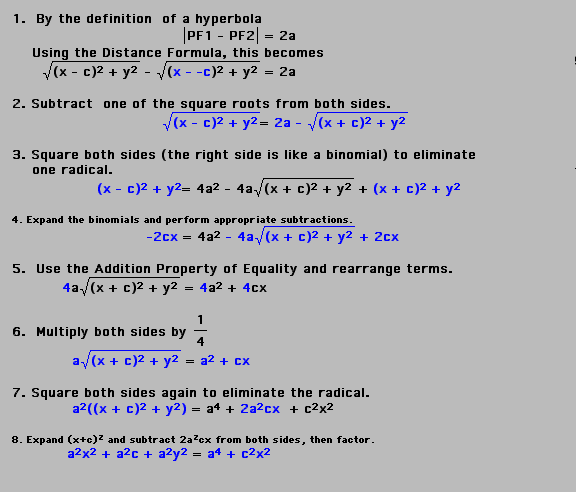
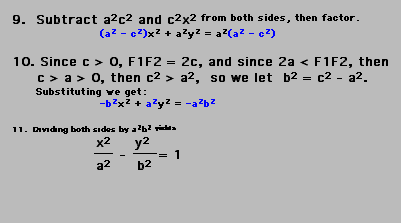
Investigation Section
Activity 1 - Technology Connection
The following presents how the hyperbola
changes graphically, as we change items from the standard equation.
Animation is provided in the examples shown below, where each
of the parameters within the equation are changed within a given
range.
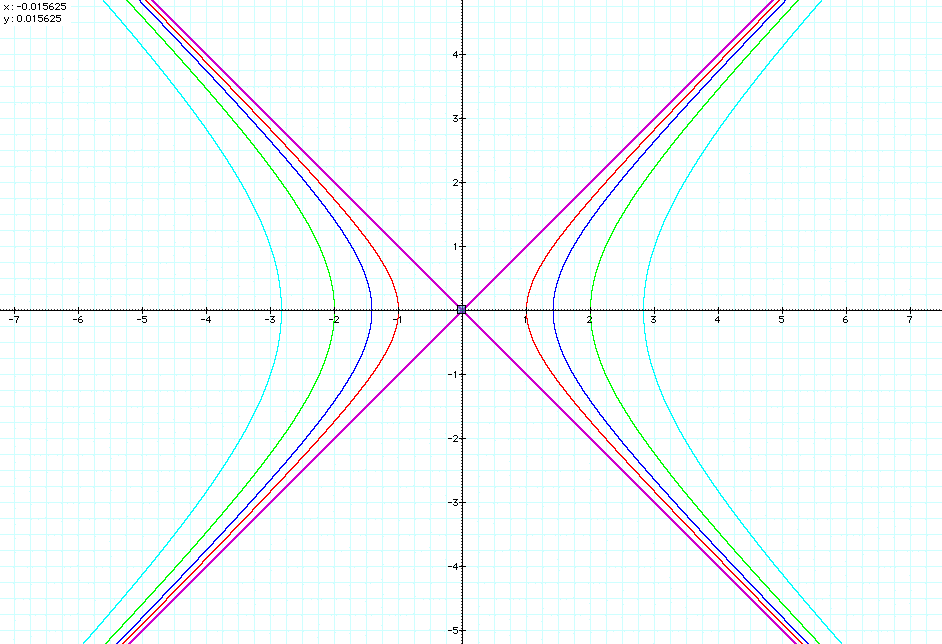
The affects of changing the "k"
value is shown above for k = 0, 1, 2, 4, 8
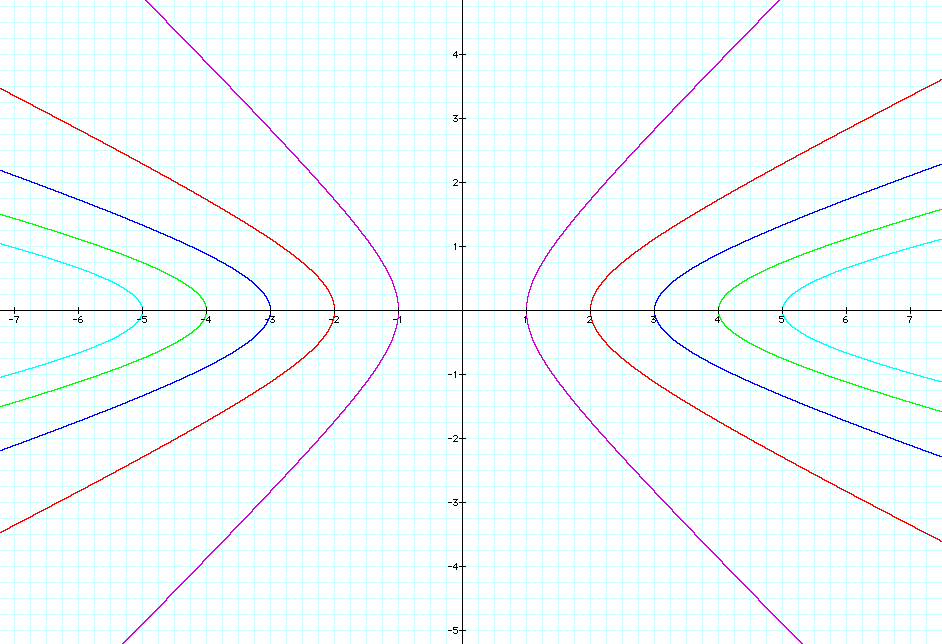
The affects of changing the "a"
value is shown above for a = 1, 2, 3, 4, 5
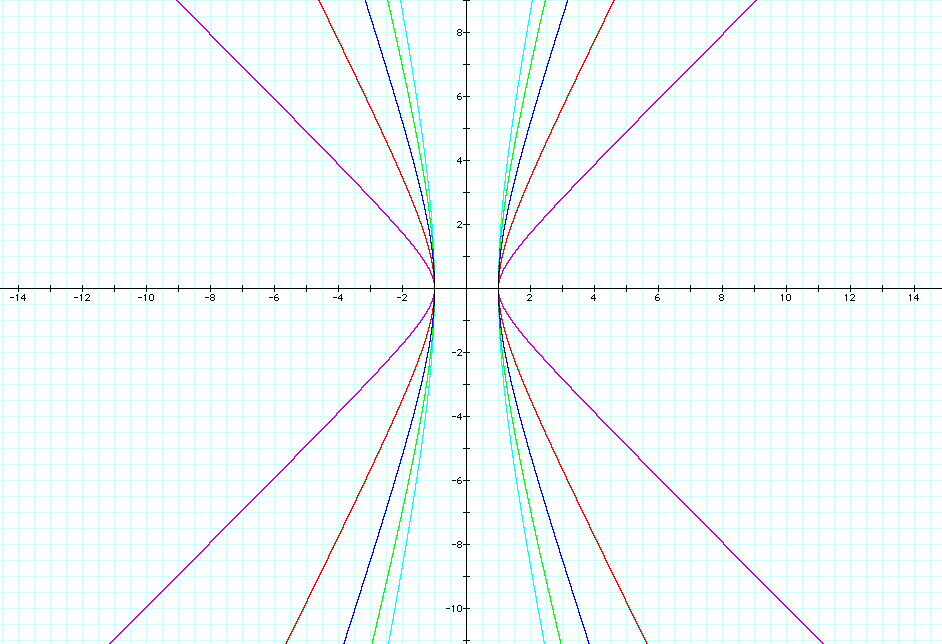
The affects of changing the "b"
value is shown above for b = 1, 2, 3, 4, 5
Lesson 4 Day 1 Activity - Graphing
Calculator File
If you have the Graphing Calculator application
on your computer, you can use the link above to work with the
file and further investigate the equation for the hyperbola.
Return to Lesson 4, Day 1 Page










